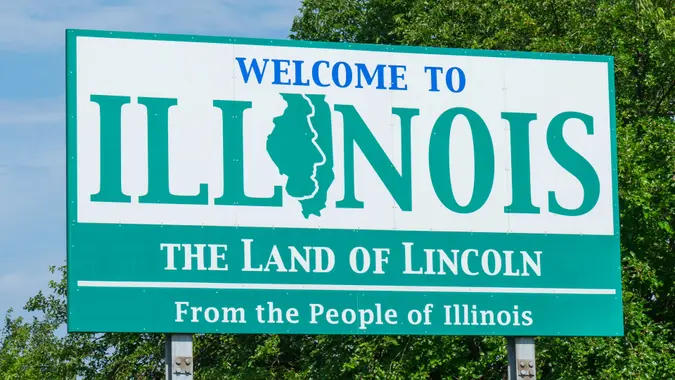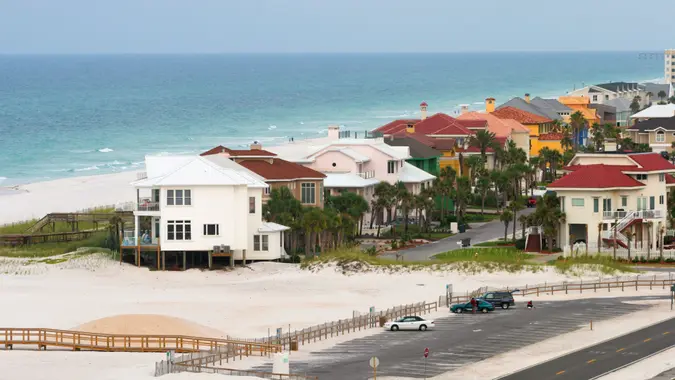Interest Rates Are Falling: 4 Ways This Impacts Home Prices

Commitment to Our Readers
GOBankingRates' editorial team is committed to bringing you unbiased reviews and information. We use data-driven methodologies to evaluate financial products and services - our reviews and ratings are not influenced by advertisers. You can read more about our editorial guidelines and our products and services review methodology.

20 Years
Helping You Live Richer

Reviewed
by Experts

Trusted by
Millions of Readers
At its last meeting of the year, the Federal Reserve paused its interest rate hikes yet again. It is also widely expected that the Fed will start cutting rates at some point in 2024.
In turn, mortgage rates have been decreasing. The 30-year average rate stood at 6.62% as of Jan. 4, according to Freddie Mac. Yet, that’s still almost double where they were two years ago. To put this figure in context, the 30-year average rate stood at 6.49% on Jan. 3, 2023; 3.22% on Jan. 6, 2022; and 2.65% on Jan. 7, 2021, according to Freddie Mac data.
“With the expectation of rate cuts this year from the Federal Reserve, as well as receding inflationary pressures, mortgage rates will likely continue to drift downward as the year unfolds,” Freddie Mac stated in a release, adding, however, that while lower rates are welcome, homebuyers are still dealing with the dual challenges of low inventory and rising (and high) home prices.
Lower Interest Rates Boost Buyer Purchasing Power
Realtor.com data showed that the median listing price of a home was up 1.2% in December compared to the previous year — to $410,000 — a significant 36.7% increase over December 2019.
Danielle Hale, Realtor.com chief economist, said the most direct way that falling interest rates could impact home prices is to push them a bit higher.
“Our 2024 housing forecast anticipated that home prices would fall slightly for 2024 as stretched buyers consider alternatives to buying existing homes such as continuing to rent or buying newly built homes,” she said.
But as interest rates have fallen faster than anticipated, this boosts buyer purchasing power — and may lead to purchases among households that otherwise might have chosen to rent.
“This effect is likely to be strongest in pricey markets, and it may already be at play in areas like Southern California where median listing prices are up by double digits in Los Angeles and 9% in San Diego in December,” she said.
Meanwhile, major East Coast markets such as Boston (+6.8%) and New York (+11.6%) have also seen hefty price growth, per Hale.
“A lower rate for home shoppers is almost like having your cake and eating it, too,” she added, noting that it offers shoppers the flexibility to boost their home purchase budget while keeping their monthly cost the same — or to cut back on their monthly payment without sacrificing the total amount they can spend.
Falling Interest Rates Might Trigger Homeowners To Be ‘Unlocked’ Faster From Their Existing Low-Rate Mortgage
About two-thirds of homeowners have rates under 4% and more than 90% have a rate less than 6%, said Hale, so mortgage rate lock is still an important phenomenon.
“But the faster mortgage rates drop, the faster we’ll see this effect wane,” Hale said. “In fact, in December, Realtor.com data showed that in 19 of the 50 largest metro areas, new listing counts were up by double-digits compared to the prior year, suggesting that this factor could already be impacting the housing market.”
Yet, Low Rates Might Also Spur More Competition
One potential drawback of lower mortgage rates is would-be buyers will likely see other households heading back into the purchase market, which means more competition, per Hale.
“As a result, it will likely be even more important for shoppers in 2024 to be prepared when they decide they want to buy a home,” she noted. “Fortunately, an abundance of digital tools make it easier than ever to get ready.”
Low Rates May Level the Playing Field Between Cash Buyers and Those Who Require a Mortgage
Jeremy Bohne, founder of Paceline Wealth Management, said that when interest rates fall, home prices tend to rise. People can afford a larger monthly payment, even though home prices are already very high.
“The combination of falling interest rates and scarce inventory means that prices may continue to rise, but lower rates do help to level the playing field between cash buyers and those who need a mortgage,” he added.
Yet, while declining mortgage rates and some improvements in for-sale inventories will help home sales activity in 2024, the increase is likely to be muted as existing inventory is still trending along historical lows. A full 90% of current homeowners with a mortgage are locked-in with a mortgage rate below 5.5%, said Selma Hepp, chief economist at CoreLogic.
“Our forecast suggests a low single-digit increase in total home sales with new home sales driving some of the increase. Given the lack of existing homes for sale, newly built homes, which have been on a rise, have been making up a larger share of total sales than in the past,” she added.
Does This Mean Homebuyers Should Have More Hope This Year?
“Optimism about the future seems to be a prerequisite for homebuyers, and today’s shoppers have it,” said Hale, adding that according to recent research from Realtor.com, 76% of first-time homebuyers think the dream of homeownership is still possible to achieve.
“The increase in existing homes available for sale and the boost in purchasing power from lower mortgage rates are key reasons for homebuyer optimism in 2024,” she added.
More From GOBankingRates
 Written by
Written by  Edited by
Edited by 

























